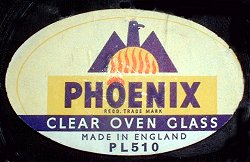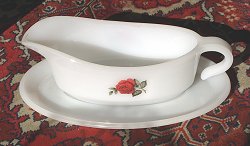 |
The British Heat Resisting Glass Company"Phoenix"
|
 |

Cardboard box for a casserole |
Joan Norman joined the company in 1956. She had been earning £4 a week until then but at Phoenix she got £14 per week! Joan was employed in packing the glassware and was one of a team which consisted of her aunts and cousins. The packing was done with wood wool and straw, in cardboard boxes which were then banded before despatch. They were doing a lot of work for catalogue sales and for the export trade. She remembers Anthony Jell, the son of the owner and "a big, tall chap", walking round the factory but he never stopped to talk. |

paper label on a clear glass dinner plate |
Barbara Garratt remembers that the company seemed to be going strong in the 1960s, including making a lot of sales through the large mail order companies. Freezie Freestone's article shows they were still going strong in 1964. The article was published at a time when Freezie, having joined the firm from Fry's in London in 1935, was moving back to London, to Phoenix's Mayfair offices in Berkeley Square to be the personal assistant to the sale director. Freezie recalls that when she joined in 1935 100 people worked for the firm; in 1964 they employed over 750. |
Marion Smith remembers joining the firm in 1939, at the age of 14 and a half. After the Christmas rush she was laid off and found work elsewhere. After the war she worked for Phoenix on several different occasions. Her first job there was on the conveyors, where everything had to be labelled as it went by. But mostly Marion worked in the Technical Glass department, where they made a variety of specialist items, including glass caps for milking machines and electrical connectors in all sizes. One of the girls, Julie, was once found wearing some of the smaller ones as ear rings! Marion did such jobs as placing the gradation transfers on measuring jugs - work requiring great accuracy - after which they went into the annealing ovens where the cellophane burnt off and the gradation marks were fired into the glass. This department also sprayed on the colour of the coloured tableware and Marion was often engaged in wiping the spray off the rims to give a clear edge. After spraying these items were also fired in the annealing ovens.

Jug with yellow rose (located by Alan Bickley) |
The large building later used as a furniture store
was mainly used by Phoenix as a warehouse and distribution centre.
The actual glass making went on between there and the canal.
Marion's working hours were 8 am to 5 pm with one hour for lunch. But when her children came along she was allowed to work flexible hours - as long as she kept up with her quota, which she did by working hard and at high speed. The company were reasonable about that sort of thing and were considered to be good employers. They also allowed a staff discount on all their products. |

gravy boat with red rose (located by Alan Bickley) |
Ted Garbett recalls that Phoenix dumped their waste
goods - "mountains of the stuff" - on the official tip in Dudley
Street, which was on the site of several old mine shafts.
Marion adds that the items dumped would mostly have been those which had been rejected by the "viewers" on the production line; and that a lot of waste glass, called "cullett", was melted down again and recycled. |
|
The company closed in August 1970. Why this collapse, which seems quite sudden, happened is not known. There is some suggestion that their domestic glassware was thought to be not as good as Pyrex in that it discoloured, did not clean as well and was more prone to breaking. If this was the case, or even if it was widely thought to be the case, that may have been sufficient to drive the company out of business when times got hard and competition increased. But there have always been suggestions that there was something odd about the closure. In March 2009 and we heard from Alan Culkin who had worked for James A. Jobling of Sunderland who made Pyrex, Phoenix's main rival. (Joblings later became Corning Ltd. then Newell Ltd. and finally ARC International; the plant closed in September 2007). Alan has kindly drawn out attention to this extract from the book: "Pyrex, the Final Meltdown" written by another ex-employee of JAJ, Phil Fairclough. It reads:
The date of 1973 does not tie up with our date, which is quite firm, of 1970. The difference may be a simple mistake or it may be that Phoenix still had their entire stock and three years after closure were trying to dispose of it. But there is something which rings true about the rest of Phil Fairclough's story, which seems to tie up with the generally cavalier attitude of Phoenix. The site of the factory is now occupied by the Phoenix industrial estate.
|